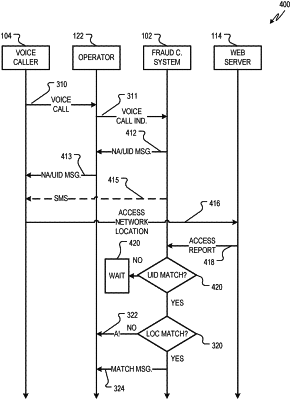| CPC H04M 3/5183 (2013.01) [G06Q 20/4016 (2013.01); H04M 2203/6027 (2013.01); H04W 4/14 (2013.01)] | 20 Claims |

|
1. A computer-implemented method of detecting potentially fraudulent voice calls to a financial services institution, the method comprising:
receiving, by a computing system, an indication of a voice call placed by a voice caller to an operator, wherein a network address indicator describing a network location is provided to the voice caller;
receiving, by the computing system, an indication of a financial services account indicated by the voice caller;
receiving, by the computing system, an indication of an access to the network location by a remote device;
determining; by the computing system using the indication of the access to the network location, a geographic location associated with the remote device;
determining, by the computing system, that the geographic location associated with the remote device matches a second geographic location associated with the financial services account;
generating, by the computing system, unique identifier data;
providing the unique identifier data to the voice caller via the voice call;
receiving, by the computing system, an indication that the unique identifier data was received from the remote device via the access to the network location; and
responsive to the determining that the geographic location associated with the remote device matches a second geographic location associated with the financial services account and to receiving the indication that the unique identifier data was received from the remote device via the access to the network location; sending a match message to the operator, the match message indicating a low risk that the voice call is fraudulent.
|